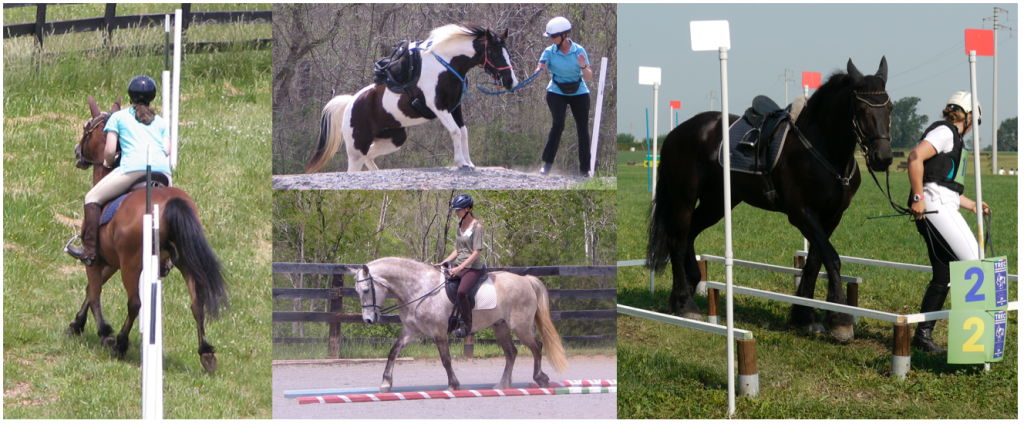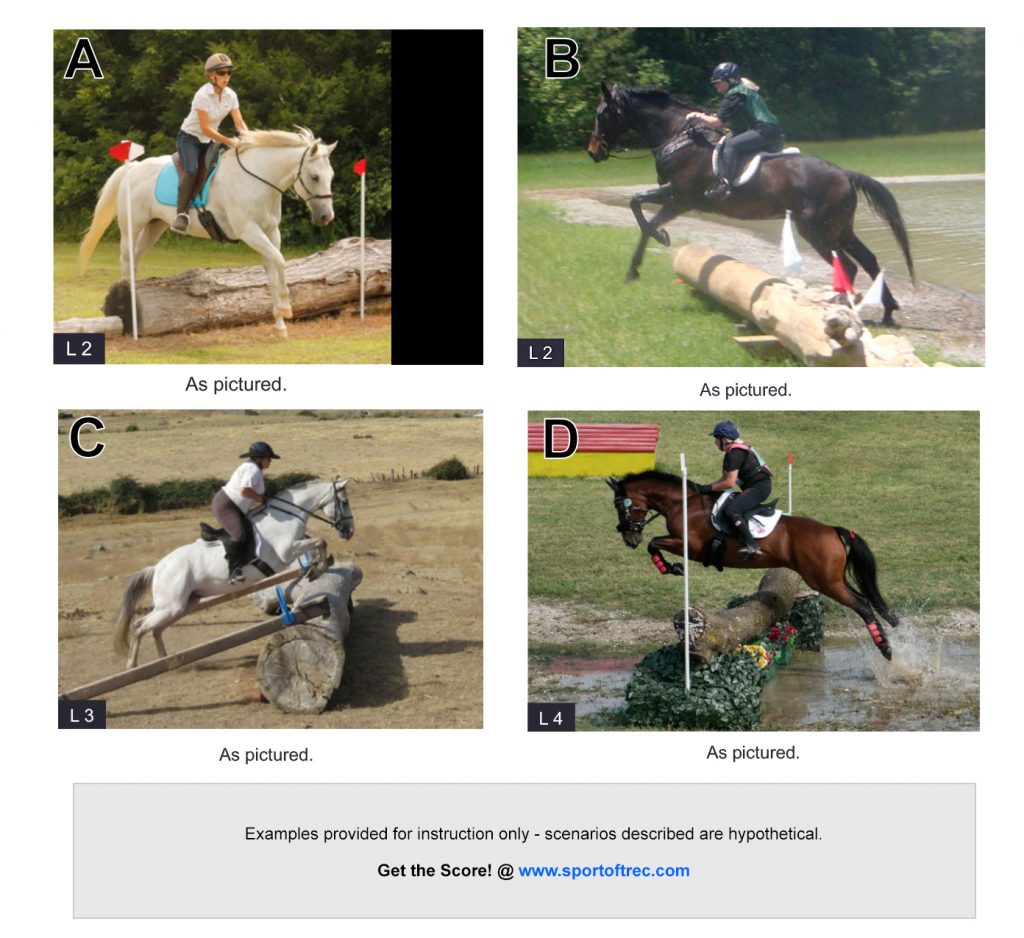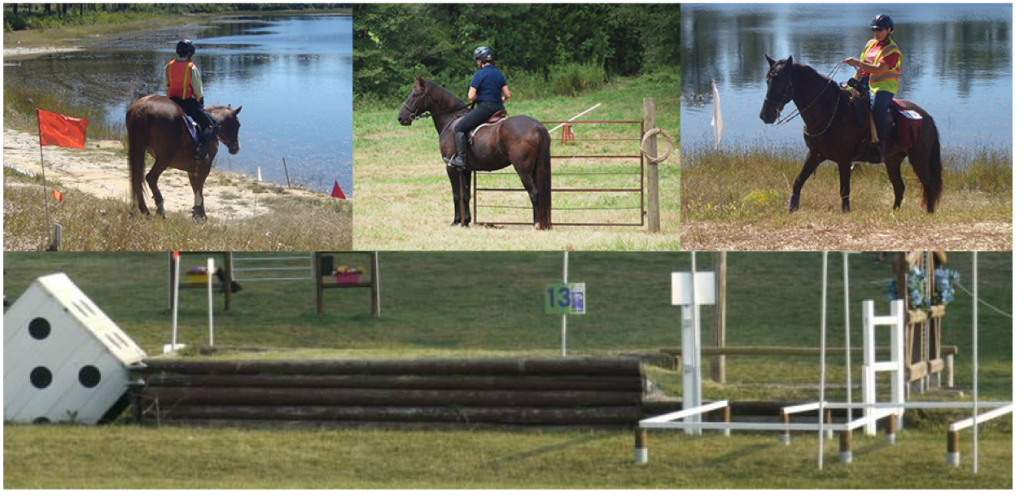
Phase III of a Ridden TREC Competition / Points: 100 – 160
This phase is also known as Parcours en Terrain Varie or PTV.
OVERVIEW:
This phase is designed to give an indication of the horse and rider’s suitability to cope with obstacles and difficulties that might be encountered while riding in the countryside, and demonstrate the partnership of horse and rider working calmly and efficiently together. This is often seen as the most exciting and popular phase for spectators!
This phase generally consists of 10-16 TREC Obstacles worth 10 points each.
Obstacles are judged on how accurately they are performed, the willingness of the horse, and correct use of the aids and position of the rider.
While this phase does include some cross-country type jumping efforts, the size of the obstacles are set according to the level of competition (See below).
The course also includes some tasks which must be undertaken while dismounted, as well as tests of obedience and calmness.
Distance: The PTV is typically 1km to 5kms long.
Time: While not a race, there is an overall maximum time set for the course. If the maximum time is exceeded time penalties accrue.
Levels: USA
| LEVEL | I | II | III | IV |
| Jump Maximum | 2’-0” (.609m) | 2’- 6” (.762m) | 3’-0” (.914m) | 3’-3” (1.07m) |
| Jump Minimum | 1′ – 0” | 2’-0” | 2’-6” | 3′-0” |
| Course Design:Standard FITE widths used for all elements. | Inviting.Easy distances between obstacles. | Moderate.More challenging routes may be introduced. | Challenging.Obstacle combinations introduced. | Difficult.Combinations and more challenging routes to be expected. |
| Time Allowed: | Ample | Reasonable | A Consideration | A Factor |
Maximum jump sizes are typically reserved for championship competitions.
Participants are encouraged to wear body protectors at all levels.
SCORING:
TREC obstacles are scored based on 3 factors:
• Effectiveness
• Obstacle Type (Choice of Gait, Style, or Timed)
• Penalties
Note: Unlike the orienteering phase (POR) – a rider will not accrue a negative score in this phase. Any obstacle scored at 0 or below = no score for that obstacle.
In addition: Each obstacle is optional and does not incur elimination if bypassed – as long as the rider indicates to the obstacle judge that that is their intention.
EFFECTIVENESS (E Score) 0 to 7 points
The E Score indicates whether or not the obstacle was completed and how well. In a TREC competition, an obstacle judge scores disobediences that occur BEFORE the obstacle, as well as errors that occur IN the obstacle, indicated by flags (red on the right / white on the left). Most obstacles have additional E Faults based on the specific task at hand.
Effectiveness Faults (E Score) -3 per incident
BEFORE the obstacle:
– Running Out
– Error of Course Corrected
– Stepping Back
– Refusal
– Circling
IN the obstacle:
– Break of Gait
– Other / Obstacle Specific
OBSTACLE TYPES
Scoring varies based on the specific obstacle type. These include:
• Choice of Gait Obstacles
• Style Obstacles
• Timed Obstacles
CHOICE OF GAIT OBSTACLES (G Score) 0 to 3 Points + E Score
Points are based on the gait at which the obstacle is performed.
Choice of Gait Obstacles include: Low Branches, One Handed Figure 8, Corridor, Corridor In-Hand, and Slalom.
Choice of Gait (G Score) -2 to +3 Points
LEVELS 1 & 2 / USA:
Walk: (-2) / Max. Score = 5
Trot: (0) / Max. Score = 7
Canter: (+3) / Max. Score = 10
LEVELS 3 & 4 / USA + FITE:
Walk: (X) / Max. Score = 0
Trot: (0) / Max. Score = 7
Canter: (+3) / Max. Score = 10
For break of gait: the lowest gait is scored. Recovery of the original gait NA.
STYLE OBSTACLES (S Score) -2 to +3 Points
Points are based the quality of the rider’s execution, and how close they come to an ideal performance. Style faults are specified for each obstacle.
Style obstacles include most in-hand obstacles, and ridden obstacles where gait is not a factor, such as the staircase, footbridge, s-bend, water crossing, gate, reinback, and all jumping (or crossing) obstacles including the bank and the dip.
Common Style Faults: Typically -1 per incident*
Ridden Obstacles:
– Irregular Forward Motion
– Incorrect Rider Position, Not Over the Stirrups and Light
– Loss of Balance of the Horse or the Rider
– Incorrect Rider Aids
– Horse Moving Sideways
– Rider Not Looking Forward
– Rider Interfering With Horse’s Balance
In Hand Obstacles:
– Irregular Forward Motion
– Progression on Tense Reins
– Loss of Balance of the Horse or the Rider
– Incorrect Rider Aids
– Horse Moving Sideways
– Horse’s Nose Passing Rider’s Shoulder
(Flapping Stirrups – see Penalties below).
*Some judges start with + 3 points and subtract from there. Others start at 0 (average) and add or subtract based on the quality of the execution. Either scheme works as long as the judge is consistent throughout the competition.
TIMED OBSTACLES (T Score) 0 to 10 Points.
Points are based on a combination of Time and E Faults.
These rules are obstacle specific.
Timed obstacles include: Mount, Immobility, and Ridden Immobility.
PENALTIES (P Score)
Penalties are relatively consistent for most obstacles.
Penalties (P Score)
– Brutality (-5)
– Dangerous Handling (-5)
– Fall of Horse or Rider (Rider Excused)
– Leaving The Obstacle (-10)
– Flapping Stirrups / USA (-1)
– Other Obstacle Specific Penalties
The Obstacles:
There are 36 Ridden TREC obstacles a course designer may choose from.
View the Ridden Obstacle Gallery
Links to Obstacle Pages:
- Low Branches*
- Bank*
- One Handed Figure 8*
- Corridor In-Hand
- Corridor Ridden*
- Drop In-Hand *
- Drop Ridden *
- Step Up In-Hand *
- Step Up Ridden*
- Dip
- Staircase Down In-Hand
- Staircase Down Ridden
- Staircase Up In-Hand
- Staircase Up Ridden*
- Ditch In-Hand*
- DitchRidden*
- WaterCrossing*
- Hedge*
- Immobility*
- Immobility Ridden*
- S Bend In-Hand*
- S Bend Ridden*
- Mount*
- Mount from Block*
- Path crossing
- Footbridge In Hand*
- Footbridge Ridden*
- Incline Up In Hand
- Incline Up Ridden*
- Incline Down In Hand
- Incline Down Ridden
- Gate*
- Rein Back In Hand
- Rein Back Ridden*
- Slalom*
- Log(s) In Hand*
- Log(s) Ridden*
Obstacles marked with an asterisk include multiple examples and a judge’s comments based on TREC Rules.
Get The Score!

© Kim Stoddard
Example: Log(s) Ridden*








